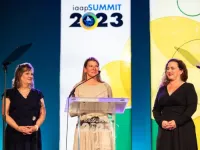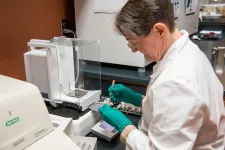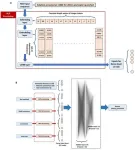(Press-News.org) ST. LOUIS – How should others make decisions for pediatric patients?
For decades, there has been debate in academic literature about the ethical principles that govern medical decision-making for children. In response to this, a group of leading scholars in pediatric ethics participated in a June 2022 symposium, “Best Interests and Beyond: Standards of Decision Making in Pediatrics,” at Saint Louis University. Over the course of three days, the 17 scholars debated one question – in the context of U.S. pediatric care, what moral precepts ought to guide parents and clinicians in medical decision-making for children?
A group of leading scholars participated in a June 2022 symposium, “Best Interests and Beyond: Standards of Decision Making in Pediatrics,” at Saint Louis University. Submitted photo.
The symposium and further discussions led to six recommendations for pediatric decision-making. Those findings, “Pediatric Decision Making: Consensus Recommendations,” appeared in Pediatrics on Aug. 9.
Erica K. Salter, Ph.D., associate professor of health care ethics and pediatrics at Saint Louis University, is the paper’s lead author. Johan Bester, M.B.Ch.B, Ph.D., associate dean for pre-clerkship curriculum at Saint Louis University School of Medicine and Lou Vinarscik, an M.D./Ph.D. student in health care ethics, also contributed to the work. Bester is an associate professor in family and community medicine and health care ethics at SLU.
The American Academy of Pediatrics offers four standards for pediatric decision-making – the Best Interest Standard, Diekema’s Harm Principle, Ross’s Constrained Parental Authority and Shared Family Centered Decision Making. This constellation of principles often confused pediatric clinicians about the ethical norms of decision-making, especially when parents and physicians disagree about a particular course of action.
The recommendations from the SLU symposium aim to provide a unified set of decision-making principles that will be more accessible and applicable for clinicians, parents and legal guardians for children from infancy to primary school.
This work brought together experts in pediatric ethics who have defended different points of view and who have different backgrounds and perspectives. The stand-out feature of this work is that they could identify points of consensus regarding which moral precepts are fundamental to medical decision-making for children.
“The fact that this group of distinguished pediatric ethicists, in particular, was able to reach consensus about these six recommendations represents an important step forward in pediatric ethics,” Salter said.
Recommendations
Parents should be presumed to have wide, but not unlimited, discretion to make health care decisions for their children.
Parents should protect and promote the health interests of their children while balancing practical constraints and/or other important obligations and interests.
A clinician’s primary responsibility is to protect and promote their pediatric patients’ health interests. Clinicians’ recommendations should be informed by professional judgment and the best available evidence.
To respect children and promote their well-being, clinicians and parents should inform pediatric patients of salient information and invite their perspective to the degree that it is developmentally appropriate.
In addition to fulfilling state-mandated reporting requirements, clinicians should seek state intervention when all less-restrictive alternatives have failed and a parental decision places the child at significant risk of serious imminent harm or fails to meet the child’s basic interests.
Clinicians and parents should strive to collaborate in a shared decision-making process to promote the child’s interest.
“With these recommendations, we hope that pediatric providers feel better equipped to engage in decision-making with parents and patients, especially when there may be disagreement. It can be very distressing when providers and parents disagree about what treatment option is best for a given child, but differences of opinion are not uncommon and should sometimes be expected,” said Salter.
“The recommendations demonstrate that parents and physicians come to the decision-making table with different sets of priorities because they play different roles in the decision-making process. Pediatric providers can now engage in those discussions with a better sense of their role and its ethical justification.”
This work will help practicing clinicians and bioethicists to make decisions for children grounded in shared moral values. These principles will also help with teaching of pediatric ethics, and with guiding academic work in the field of pediatric ethics.
The authors say further evaluation is needed to determine if these principles apply to newborn babies, teenagers and wards of the state or if modifications are needed for those patient populations.
Sponsors of the symposium include the Harvey and Bernice Jones Chair in Pediatrics at Arkansas Children’s Hospital, the Gnaegi Center for Health Care Ethics, Saint Louis University’s Mellon Award, Saint Louis Children’s Hospital and SSM Health.
Other authors include D. Micah Hester, Ph.D., University of Arkansas for Medical Sciences and Arkansas Children’s Hospital; Armand H. Matheny Antommaria, M.D. Ph.D., Cincinnati Children’s Hospital and University of Cincinnati College of Medicine; Jeffrey Blustein, Ph.D., City College of New York; Ellen Wright Clayton, M.D. J.D., Vanderbilt University Medical Center and Vanderbilt University; Douglas S. Diekema, M.D. MPH, University of Washington School of Medicine; Ana S. Iltis, Ph.D., Wake Forest University; Loretta M. Kopelman, Ph.D., East Carolina University and Georgetown University; Jay R. Malone, M.D. Ph.D., Washington University in St. Louis; Mark R. Mercurio, M.D., Yale University School of Medicine; Mark C. Navin, Ph.D., Oakland University and Corwell Health East; Erin Talati Paquette, M.D. J.D., Northwestern University and Ann and Robert H. Lurie Children’s Hospital of Chicago; Thaddeus Mason Pope, J.D. Ph.D., Mitchell Hamline School of Law; Rosamond Rhodes, Ph.D., Icahn School of Medicine at Mount Sinai; and Lainie F. Ros, M.D. Ph.D., University of Chicago and the University of Rochester.
Albert Gnaegi Center for Health Care Ethics
The Albert Gnaegi Center for Health Care Ethics at Saint Louis University is committed to excellence in teaching, service and research in health care. Engaging in both secular and religious discourse, the center brings Catholic, Jesuit tradition into the interdisciplinary study of philosophical and legal bioethics.
Saint Louis University School of Medicine
Established in 1836, Saint Louis University School of Medicine has the distinction of awarding the first medical degree west of the Mississippi River. The school educates physicians and biomedical scientists, conducts medical research, and provides health care on a local, national and international level. Research at the school seeks new cures and treatments in five key areas: cancer, liver disease, heart/lung disease, aging and brain disease, and infectious diseases.
END
SLU ethicists, leading scholars publish guidance for parents, physicians making medical decisions for children
2023-08-11
ELSE PRESS RELEASES FROM THIS DATE:
Hundred-year storms? That's how long they last on Saturn.
2023-08-11
The largest storm in the solar system, a 10,000-mile-wide anticyclone called the Great Red Spot, has decorated Jupiter's surface for hundreds of years.
A new study now shows that Saturn — though much blander and less colorful than Jupiter — also has long-lasting megastorms with impacts deep in the atmosphere that persist for centuries.
The study was conducted by astronomers from the University of California, Berkeley, and the University of Michigan, Ann Arbor, who looked at radio emissions from the planet, which come from below the surface, and found long-term disruptions in the distribution ...
New concussion headset shows when it's safe to return to play
2023-08-11
A new digital headset designed to measure alterations in brain function could change decisions about how quickly an athlete is ready to return to play after a concussion. In an evaluation of the device, UC San Francisco researchers found it revealed brain changes even in athletes whose concussion symptoms had gone away, suggesting they could be playing too soon.
Although not yet approved by the Food and Drug Administration (FDA), the device could fill an important niche among athletes, clinicians, trainers and coaches, who are concerned about the long-term effects of repeated sports-related concussions. These include chronic traumatic encephalopathy, ...
CORRECTION: Outdoor air pollution may increase non-lung cancer risk in older adults
2023-08-11
*This press release was amended on August 9, 2023. Due to a mistake in interpretation of data, the previous version of the release stated the study found that NO2 exposure is associated with a decreased risk of breast cancer. The authors have confirmed that the results showed that NO2 exposure is associated with an increased risk of breast cancer.
Key points:
A cohort study of millions of Medicare beneficiaries found that chronic exposures to PM2.5 and NO2 over a 10-year period increased the risk of developing colorectal and prostate cancers.
Even in areas with low pollution levels, researchers found substantial associations between exposures to ...
Zhong named Institute of Food Technologists fellow
2023-08-11
Qixin Zhong, professor in the University of Tennessee Department of Food Science, has been named an Institute of Food Technologists (IFT) Fellow.
The honor was bestowed as a result of Zhong’s years of contribution to food science and to IFT through his scientific, engineering and leadership efforts. In his research enhancing food quality, safety and healthfulness, Zhong creates multilength scale structures to improve the function of food ingredients. His cutting-edge innovations and research developments have impacted countless producers and consumers.
Zhong says he is honored to be named a Fellow, and ...
University of Tennessee extension wins “Employer of the Year” from international organization
2023-08-11
Ask just about any person in the University of Tennessee Extension family what they like about their job, and they might mention the impact they have in their communities and the people they help. Long thought of as a career where you can realize a calling for service, an international organization now confirms what many employees have believed for some time – that UT Extension is a great place to work.
The International Association of Administrative Professionals (IAAP) has named UT Extension as its 2023 Employer of the Year. This ...
Interdisciplinary team studies decomposition effects on soil
2023-08-11
Forensic researchers at the University of Tennessee Knoxville’s famous Anthropological Research Facility, popularly known as the “Body Farm,” have made headlines for decades in their discoveries of what happens to human bodies after death. Now, a multidisciplinary team—engineers, soil scientists, and biologists—digs in with them for a deeper look at what happens to the soil underneath a decomposing body. Their study, “Soil Elemental Changes During Human Decomposition,” published in June 2023 by PLOS One, could benefit investigators searching for human remains in remote or hard-to access-vegetated areas.
“This ...
Arrays of quantum rods could enhance TVs or virtual reality devices
2023-08-11
Cambridge, MA – Flat screen TVs that incorporate quantum dots are now commercially available, but it has been more difficult to create arrays of their elongated cousins, quantum rods, for commercial devices. Quantum rods can control both the polarization and color of light, to generate 3D images for virtual reality devices.
Using scaffolds made of folded DNA, MIT engineers have come up with a new way to precisely assemble arrays of quantum rods. By depositing quantum rods onto a DNA scaffold in a highly controlled way, the researchers can regulate their orientation, which is a key factor in determining the polarization of light emitted by the array. This makes it easier ...
Artificial intelligence designs advanced materials
2023-08-11
In a world where annual economic losses from corrosion surpass 2.5 trillion US Dollars, the quest for corrosion-resistant alloys and protective coatings is unbroken. Artificial intelligence (AI) is playing an increasingly pivotal role in designing new alloys. Yet, the predictive power of AI models in foreseeing corrosion behaviour and suggesting optimal alloy formulas has remained elusive. Scientists of the Max-Planck-Institut für Eisenforschung (MPIE) have now developed a machine learning model that enhances the predictive accuracy by up to 15% compared to existing frameworks. This model uncovers new, but realistic corrosion-resistant alloy compositions. ...
Even treated wastewater affects our rivers
2023-08-11
Effluents from wastewater treatment plants have a dual effect: Some species disappear, while others benefit. Especially certain insect orders, such as stonefly and caddisfly larvae, are decimated. Certain worms and crustaceans, by contrast, can increase in number. A team from Goethe University Frankfurt led by Daniel Enns and Dr. Jonas Jourdan has corroborated this in a comprehensive study, which has now been published in the journal Water Research. They examined 170 wastewater treatment plants in Hesse in relation to species composition.
Wastewater treatment plants are ...
Study: Infant formula safety checks can be improved with stratified sampling
2023-08-11
URBANA, Ill. – Producers of infant formula employ comprehensive food safety systems, including product testing to ensure those systems are working. A new study from the University of Illinois Urbana-Champaign finds that some testing methods are more powerful at catching contaminants than others.
Spacing out samples over time in a stratified sampling pattern is better at catching risky pathogens like Cronobacter than randomly sampling from the product as it is being produced, the researchers found. Furthermore, while taking more samples of product generally increases the chance to catch the pathogen, there is a point after which it ...






